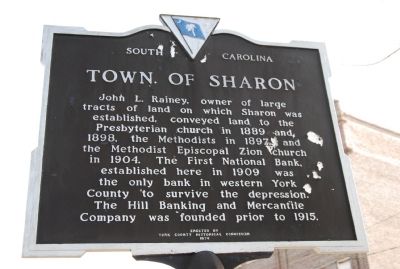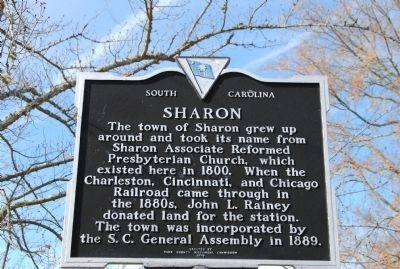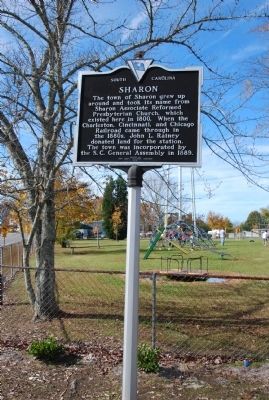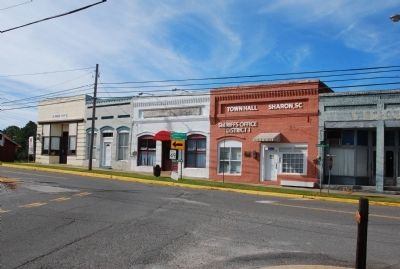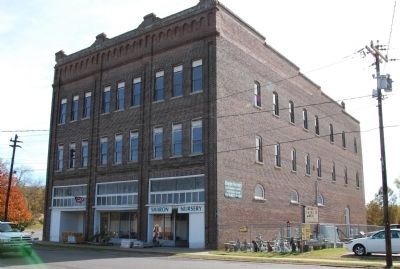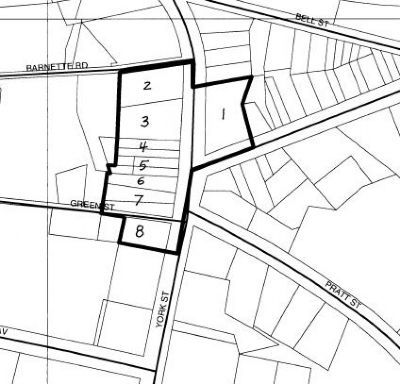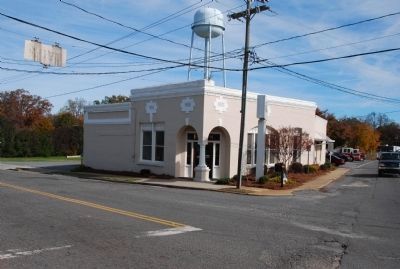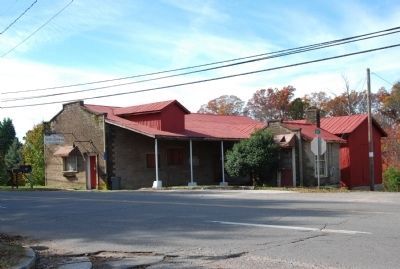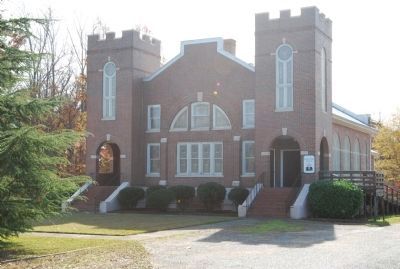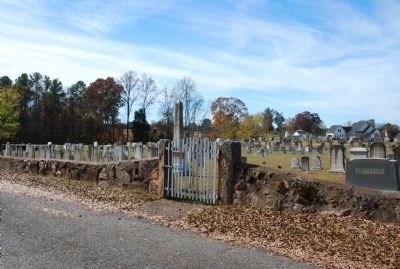Sharon in York County, South Carolina — The American South (South Atlantic)
Town of Sharon / Sharon
Town of Sharon
John L. Rainey, owner of large tracts of land on which Sharon was established, conveyed land to the Presbyterian church in 1889 and 1898, the Methodists in 1897, and the Methodist Episcopal Zion church in 1904. The First National Bank, established here in 1909, was the only bank in western York County to survive the depression. The Hill Banking and Mercantile Company was founded prior to 1915.
Sharon
The town of Sharon grew up around and took its name from Sharon Associate Reformed Presbyterian Church, which existed here in 1800. When the Charleston, Cincinnati, and Chicago Railroad came through in the 1880s, John L. Rainey donated land for the station. The town was incorporated by the S.C. General Assembly in 1889.
Erected 1979 by York County Historical Commission. (Marker Number 46-12.)
Topics and series. This historical marker is listed in these topic lists: Railroads & Streetcars • Settlements & Settlers. In addition, it is included in the South Carolina, York County Historical Commission series list. A significant historical year for this entry is 1889.
Location. 34° 57.11′ N, 81° 20.286′ W. Marker is in Sharon, South Carolina, in York County. Marker is at the intersection of York Street and Bell Avenue, on the left when traveling north on York Street. Touch for map. Marker is in this post office area: Sharon SC 29742, United States of America. Touch for directions.
Other nearby markers. At least 10 other markers are within 7 miles of this marker, measured as the crow flies. Town of Sharon Stone Marker (here, next to this marker); First National Bank of Sharon (about 700 feet away, measured in a direct line); Dickey - Sherer House (approx. 3.3 miles away); Blairsville Schools (approx. 3.4 miles away); Hickory Grove Schools (approx. 4.7 miles away); Hickory Grove (approx. 4.7 miles away); Unity Academy (approx. 5.6 miles away); Sadler Store (approx. 5.8 miles away); Barnett Brothers Circus, 1929 ~ 1945 / Bennett Brothers Circus, 1929 ~ 1938 (approx. 6.1 miles away); Bratton House Site / Jefferson Davis's Flight (approx. 6.1 miles away). Touch for a list and map of all markers in Sharon.
Also see . . .
1. Sharon Downtown Historic Distric. The Sharon Downtown Historic District is a significant collection of commercial and industrial buildings which illustrate the development of the commercial core of the small community of Sharon since its beginnings in the late 1880s. (Submitted on February 2, 2010, by Brian Scott of Anderson, South Carolina.)
2. John L. Rainey (1844-1924) - Find a Grave Memorial. Sharon Associate Reformed Presbyterian Churchyard, Sharon, York County, South Carolina. (Submitted on February 2, 2010, by Brian Scott of Anderson, South Carolina.)
Additional commentary.
1. Sharon Downtown Historic District
The Sharon Downtown Historic District includes nine contributing properties fronting on York Street (S.C. Highway 49) and Woodlawn Street in downtown Sharon, in western York County, South Carolina; the district includes no noncontributing properties. The district consists primarily of masonry commercial buildings built between 1908 and 1944 which historically housed a variety of businesses serving the developing town of Sharon in the first half of the twentieth century.
1. First National Bank of Sharon (1909), 4028 Woodlawn Street: This one-story brick building with limestone features was built by contractor W.W. Blair for the First National Bank of Sharon. The one-part commercial block building features a comer entrance with arched openings to provide access to the recessed entrance from both Woodlawn and York Streets. The large arches have keystones and are supported by a single tapered column at the comer. The south side has a large tripartite window with transom and an arched surround with keystone. A smaller one-light window on the south side has a similar design. Above the windows are large vents with brick surrounds and decorative limestone blocks. The walls are capped by brick corbelling. The west side, which faces Woodlawn Street, has similar fenestration but with fewer decorative elements. To the east is a one-story brick addition. The building currently (2001) houses a branch of First Citizens Bank of South Carolina.
2. Shannon Building (ca. 1910), 4029 Woodlawn Street: This property is one of six commercial buildings in a block facing Woodlawn and York Streets. It was built about 1910 for H. Wesley Shannon and James D. Hope. The partnership went through several changes. In 1918, Mrs. J.A. Shannon and others taught business courses in the building. In the 1920s, it housed a dry goods and grocery store operated by George A. Plexico on the first floor and a millinery shop on the second floor was run by Mrs. D.A. Whisonant. A dress shop was operated in the 1930s by W.S. Gibson, and a furniture store in the 1940s was operated by Luther Hartness. The building currently (2001) houses a body shop and wrecker service. The two-story brick building is a two part commercial block. The facade has brick corbelling at the cornice and three second-floor windows with brick arches above. A beltcourse divides the first and second levels. The first floor has a recessed center entrance with double door and transom. The storefront has plate-glass windows with the transoms covered with wood. The flat roof slopes to the rear, and the side walls have irregularly-placed windows and low parapets which step down to the rear.
3. Plexico Building (ca. 1910), 4027 Woodlawn Street: This one-story brick building was constructed for J.M. Plexico, who operated a general store and drugstore. It was later a grocery store, operated by J.L. Whitesides, John R. Cobb, and F.H. Youngblood. The building currently (2001) houses a video store. The one-part commercial block has a storefront with recessed panels above it. A beltcourse of vertical bricks set at an angle provides a decorative element. The center of the storefront has a brick column in front of the recessed central door.
4. Love Building (ca. 1910), 4025 Woodlawn Street: This one-story brick building was constructed for M.B. Love to house a furniture store. By 1918. a grocery store was being operated in the building by Walter B. Hayes. Before 1930. Dr. H.C. Floyd opened a drugstore here; it later housed a five-and-dime store run by the Jones sisters. The building is currently (2001) owned by the Town of Sharon and houses the Town Hall and a York County Sheriff substation. The one part commercial block features corbelling near the cornice, recessed panels, and a beltcourse on its facade. The entrance is to the right. with a door and transom and a small window. The left section of the facade has a large four-light window with a brick hood.
5. Kennedy Building (ca. 1910), 3725 York Street: This one-story brick building is very similar to the adjacent Love Building. Built for Christopher Kennedy as a mercantile store. it has seen various commercial uses through its history. It currently (2001) houses Storky's Arcade and Pizza. The facade features corbelling, a recessed panel. and a beltcourse. The central double door is flanked by two-over-two windows with arched openings and brick hoods.
6. Hope Building (ca. 1910), 3723 York Street: This one-story brick building was built by John L. Rainey in what had been an alley between two buildings. S.A. "Sam" Hope, a cobbler, operated a business here. along with a grocery store. After Hope's death, W.A. Maloney purchased the building and business. Groceries were sold in the building by A.B. Good and Mrs. May Bell Kennedy. Because the building was built in a former alley, it narrows from front to rear. The one part commercial block has simple corbelling at the cornice and narrow panels on the facade with corbelling. The central double door has a transom and an arched hood. The two-over-two windows flank the central entrance and have similar arched openings.
7. Sims-Hood Drug Store (ca. 1908), 3721 York Street: This one-story brick building was built by John L. Rainey about 1908 and housed drug stores operated by the Sims and Hood families. It currently (2001) houses the Sharon Barber Shop. The one-part commercial block has a wood panel above the storefront. The central double door is recessed with windows on either side. The facade has recessed brick courses. The south wall is exposed, and shows evidence of a building having been attached to it at some earlier date.
8. John L. Rainey Cotton Gin and Seed House (1944), York Street: The cotton gin is a one-story concrete block building featuring an entrance door and simple stepped parapet on the end gable and a standing-seam metal roof; the seed house is a one-story building with metal siding and a gable roof. A shed connects the cotton gin. seed house. and office.
9. John L. Rainey Office (1944), York Street. This one-story concrete block building features an entrance door and simple stepped parapet on the end gable and a standing-seam metal roof.
Significance
The Sharon Downtown Historic District is a significant collection of commercial and industrial buildings which illustrate the development of the commercial core of the small community of Sharon since its beginnings in the late 1880s. The nine buildings contributing to the character of this historic district provide evidence of the establishment and growth of a small downtown through the various periods of the town's development from 1888 through 1945. The properties in the district, taken as a whole, possess architectural integrity and provide an important record of the development of commerce and industry in the community. The district is eligible for listing in the National Register of Historic Places under Criterion A because its properties illustrate a broad pattern of development over a nearly sixty-year period and under Criterion C because many of its buildings are excellent examples of commercial buildings typical of small towns in the South Carolina Piedmont of the late nineteenth and early twentieth centuries.
The town of Sharon was established soon after the arrival of a railroad line in western York County in 1888.1 The rail line, known as the "Three C's" (for the Charleston, Cincinnati, and Chicago Railroad) helped to create or enhance several communities in the South Carolina Piedmont. A depot was built here in close proximity to existing roads, on a lot donated by J.L. Rainey, and a village soon began to develop around the railroad stop. The town grew up on land donated by the Rainey and Gilfillin families, and was incorporated in 1889; it was named Sharon for Sharon Associate Reformed Presbyterian Church, located nearby, which had been established in 1796. Houses and stores began to be built along the Chesterville-Shelbyville Road, which followed the route of present-day S.C. Highway 49 into town from the south and passed out of town on present-day Woodlawn Street.
The area around the intersection of this road and the York Road (present-day Woodlawn and York Streets) began to develop as the commercial and financial center of the town of Sharon by the first decade of the twentieth century.
The Yorkville Enquirer called Sharon an "Embryo City" in 1889 and predicted that it would grow as large as York. Although it served as a depot and trading center for the surrounding countryside, including most of western York County, Sharon never grew significantly. The nearby city of York, just to the east, boasted a more strategic geographical location and its status as the county seat. One writer has described the failure of many early merchants in Sharon and speculated that they lacked both experience and capital. The town, furthermore, failed to attract a textile mill, an industry which often spurred or strengthened the growth of small Southern towns. The lack of growth in the downtown area, however, has helped to preserve a significant collection of commercial buildings from the early twentieth century, offering such typical wares as dry goods, groceries, general merchandise, furniture, and drugs.
Several properties related to the cotton industry also contribute to the significance
of this historic district. The presence of the railroad enabled Sharon to thrive as a town where merchants received cotton from farmers in surrounding areas, stored it, processed it in gins, and shipped it to markets by rail. The John L. Rainey Cotton Gin, Seed House, and Office represent a late period in the cotton industry in the area. Other industries present in early twentieth century Sharon included a jug and jar factory, a woodworking and iron workshop, and several blacksmiths.
This collection of commercial and industrial buildings provides an important record of the development of a small Piedmont village. The properties within the Sharon Downtown Historic District are associated with the small business which characterized the community and helped to sustain it for many years. (Source: National Register nomination form.)
— Submitted February 2, 2010, by Brian Scott of Anderson, South Carolina.
2. John L. Rainey on his Eating Habits
A few months before his death in 1924, Sharon's John L. Rainey, another Confederate veteran, commented on his diet. "I do not eat any hog meat any more -- there is no fresh pork," said Rainey. "I can eat beek or chicken and it does not seem to hurt me -- partridge too, I can eat partridge all right." When it was suggesed that mutton
was healthy and had no side effects. Rainey responded as follows:
No mutton for me, I have not eaten a piece of mutton in sixty years, and I'll tell you what fixed me. It was during the Civil War. We had had nothing to eat for several days, because we had been fighting all the while. we came upon a pasture in which there were a number of sheep and the men shot some of them down for food. I got hold of the leg of a sucking ewe, roasted it and ate it without any bread or even salt. That fixed me. It made it sick. One man died from eating those sheep. I never tasted mutton since...We were under fire at the time we ean upon that sheep pasture, but we did not mine that so much as we did the terrible hunger from which we were suffering. I suppose I would have tried to eat a buzzard about that time if it had been all that I could have got hold of. (Source: York and Western York County: The Story of a Southern Eden
by J. Edward Lee, Jerry L. West (2002), pgs 55-56.)
— Submitted February 2, 2010, by Brian Scott of Anderson, South Carolina.
3. Hill Building
The Hill family of Sharon, was prominent in the community and to whom I’m related. William Hill, Sr. was my great uncle and my grandfather’s brother in law, Arthur Miles Erwin. Their wives, Sallie McMurray
Erwin and Mary McM. Hill, were daughters of the Rev John A McMurray, an early pastor at Woodlawn Presbyterian Church in Sharon. The Hill Bldg was built by William H Sr and housed a fully stocked store that offered everything from seeds to carriages. For its time it was a forerunner of large department stores. I’m able to furnish much information to aid in proper credit for this family’s history in the town of Sharon... Note To Editor only visible by Contributor and editor
— Submitted May 31, 2022, by Thomas M Babington of Montgomery, Alabama.
Credits. This page was last revised on July 21, 2022. It was originally submitted on November 15, 2009, by Michael Sean Nix of Spartanburg, South Carolina. This page has been viewed 2,713 times since then and 123 times this year. It was the Marker of the Week December 6, 2009. Photos: 1, 2, 3, 4, 5. submitted on November 15, 2009, by Michael Sean Nix of Spartanburg, South Carolina. 6. submitted on February 2, 2010, by Brian Scott of Anderson, South Carolina. 7, 8, 9, 10, 11. submitted on November 15, 2009, by Michael Sean Nix of Spartanburg, South Carolina. • Kevin W. was the editor who published this page.
